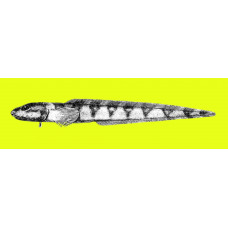Latin name
Lycodes jugoricus
Identification
Shulupaoluk has a naked body; scales are completely absent, even in the largest specimens. The chin ridges are peculiar — fused anteriorly but not completely, so the anterior tips of both ridges protrude as two tubercles. In young specimens (60–80 mm), the chin ridges are cylindrical with a convergent apex that is not completely merged. The head is broad with a pointed snout that protrudes forward more strongly than in Lycodes polaris. The vomer has blunt, nearly tubercle-shaped teeth that form an area of 11-14 teeth. This number is always smaller in other northern Lycodes species. The lateral line is mediolateral, and the pores of the dorsal row are well developed.
Features of fish fins
These fish have pectoral fins that are 16.5% of their body length and pelvic fins that are 4.1% of their body length.
Fish colouring
The coloration of the Shulupaoluk is very distinctive and easily distinguishable from that of the Lycodes polaris at all stages of life. In young specimens (6-8 cm), the body is light with a dark top of the head. A narrow, straight, light-colored stripe runs across the occiput. There are nine dark transverse stripes on the sides of the body, narrow at the bottom but club-shaped and widening above the lateral line and on the dorsal fin. The middle of the stripes is light. In a specimen that is 155 mm long, the underside of the body is pure white when alive and yellowish on the sides. The top of the head is dark. The eight stripes and the spot at the tip of the tail are blackish-brown with rather blurred edges. These broadened constrictions are considerably narrower than the light background that separates them.
Distribution
This species is found in the Arctic, including the White Sea, the southern Kara Sea, the Laptev Sea, the Novosibirsk Islands, the Kolyma River estuary area, the Chukchi Sea, and Herschel Island in the Beaufort Sea.
Habitat
This is a marine benthic species that prefers temperate climates. It lives at depths ranging from 3 to 90 meters, usually between 9 and 15 meters.
Size
Males of this species reach a maximum length of 21.1 cm.
Behavior
They inhabit shallow waters with soft, coastal bottoms, primarily in brackish waters with a salinity level of 15 to 27 percent.
Food and feeding habits
They feed on isopods, bivalves, and polychaetes.
Reproduction
This species' eggs are large, few in number, and bottom-dwelling. Apparently, the hatched fry do not pass through the pelagic stage.
Fishing
This species is not commercially important.
Relationship with a person
Harmless.
| Classification | |
| Phylum | Chordata |
| Class | Actinopterygii |
| Squad | Perciformes |
| Family | Zoarcidae |
| Genus | Lycodes |
| Species | L. jugoricus |
| Features | |
| Conservation status | Least Concern |
| Habitat | Bottom |
| Life span, years | No information |
| Maximum body weight, kg | No information |
| Maximum length, cm | 21,1 |
| Sailing speed, m/s | No information |
| Threat to people | Edible |
| Way of eating | Bentophage |
Shulupaoluk
Tags: shulupaoluk

